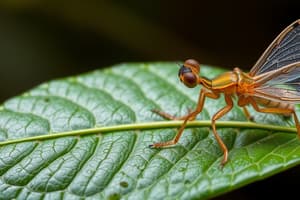Podcast
Questions and Answers
What is the primary method of reproduction for prokaryotes like bacteria?
What is the primary method of reproduction for prokaryotes like bacteria?
- Meiosis
- Cytokinesis
- Binary fission (correct)
- Mitosis
Where does meiosis occur in the human body?
Where does meiosis occur in the human body?
- In blood cells
- In most body cells
- In reproductive organs (correct)
- In skin cells
Which process is responsible for dividing the cytoplasm of a cell to form two daughter cells?
Which process is responsible for dividing the cytoplasm of a cell to form two daughter cells?
- Cytokinesis (correct)
- Binary fission
- Meiosis
- Mitosis
What major difference exists in cytokinesis between plant and animal cells?
What major difference exists in cytokinesis between plant and animal cells?
What is the haploid number of chromosomes in humans?
What is the haploid number of chromosomes in humans?
What cellular error during meiosis can lead to Down syndrome?
What cellular error during meiosis can lead to Down syndrome?
How many pairs of autosomes do humans have?
How many pairs of autosomes do humans have?
What occurs to the chromosome number per cell after mitosis?
What occurs to the chromosome number per cell after mitosis?
What does Mendel's Law of Segregation state?
What does Mendel's Law of Segregation state?
What is an allele?
What is an allele?
What occurs during the G1 (Gap 1) phase of the cell cycle?
What occurs during the G1 (Gap 1) phase of the cell cycle?
What does it mean for an organism to be homozygous?
What does it mean for an organism to be homozygous?
Which phase in mitosis involves the separation of sister chromatids?
Which phase in mitosis involves the separation of sister chromatids?
What best describes co-dominance in genetics?
What best describes co-dominance in genetics?
In a Punnett square, what determines the probability of offspring genotypes?
In a Punnett square, what determines the probability of offspring genotypes?
What key event happens during prophase I of meiosis that contributes to genetic diversity?
What key event happens during prophase I of meiosis that contributes to genetic diversity?
In prokaryotic cells, where do transcription and translation occur?
In prokaryotic cells, where do transcription and translation occur?
If two parents are both carriers for an autosomal recessive disorder, what is the likelihood their child will inherit the disorder?
If two parents are both carriers for an autosomal recessive disorder, what is the likelihood their child will inherit the disorder?
Which of the following lists the phases of mitosis in the correct order?
Which of the following lists the phases of mitosis in the correct order?
What kind of genetic expression occurs in incomplete dominance?
What kind of genetic expression occurs in incomplete dominance?
What is the primary purpose of meiosis in organisms?
What is the primary purpose of meiosis in organisms?
Which inheritance pattern is characterized by a mutated gene on the X chromosome?
Which inheritance pattern is characterized by a mutated gene on the X chromosome?
What is the main outcome of binary fission in single-celled organisms?
What is the main outcome of binary fission in single-celled organisms?
What major events occur during telophase of mitosis?
What major events occur during telophase of mitosis?
Flashcards
Asexual Reproduction in Prokaryotes
Asexual Reproduction in Prokaryotes
Prokaryotes like bacteria reproduce by dividing a single cell into two identical daughter cells.
Mitosis Location
Mitosis Location
Mitosis happens in most body cells (somatic cells) throughout the body, not just in reproductive organs.
Cytokinesis
Cytokinesis
Cytoplasm division in a cell, completing cell division.
Cytokinesis in Plants
Cytokinesis in Plants
Signup and view all the flashcards
Human Diploid Chromosome Number
Human Diploid Chromosome Number
Signup and view all the flashcards
Chromosome Number Change in Mitosis
Chromosome Number Change in Mitosis
Signup and view all the flashcards
Chromosome Number Change in Meiosis
Chromosome Number Change in Meiosis
Signup and view all the flashcards
Down Syndrome Cause
Down Syndrome Cause
Signup and view all the flashcards
SRY Gene
SRY Gene
Signup and view all the flashcards
Mendel's Law of Segregation
Mendel's Law of Segregation
Signup and view all the flashcards
Mendel's Law of Independent Assortment
Mendel's Law of Independent Assortment
Signup and view all the flashcards
Allele
Allele
Signup and view all the flashcards
Phenotype
Phenotype
Signup and view all the flashcards
Genotype
Genotype
Signup and view all the flashcards
Homozygous
Homozygous
Signup and view all the flashcards
Heterozygous
Heterozygous
Signup and view all the flashcards
Transcription Location (Eukaryotes)
Transcription Location (Eukaryotes)
Signup and view all the flashcards
Translation Location (Eukaryotes)
Translation Location (Eukaryotes)
Signup and view all the flashcards
Transcription and Translation in Prokaryotes
Transcription and Translation in Prokaryotes
Signup and view all the flashcards
Cell Cycle Phases
Cell Cycle Phases
Signup and view all the flashcards
Mitosis Phases
Mitosis Phases
Signup and view all the flashcards
Mitosis Purpose
Mitosis Purpose
Signup and view all the flashcards
Meiosis Purpose
Meiosis Purpose
Signup and view all the flashcards
Crossing Over in Meiosis
Crossing Over in Meiosis
Signup and view all the flashcards
Study Notes
Biology Study Notes
- Biology is the scientific study of life, examining its structure, function, growth, origin, evolution, and distribution.
- Characteristics of living things include: cellular organization; reproduction; growth and development; energy utilization; homeostasis; response to stimuli; adaptation.
- Evolution is the unifying theme in biology, explaining the unity and diversity of life, by proposing common ancestry.
- The three domains of life are Bacteria, Archaea, and Eukarya.
- Bacteria and Archaea are prokaryotic, lacking a nucleus and membrane-bound organelles.
- Eukarya is eukaryotic, containing a nucleus and membrane-bound organelles.
- Eukaryotic organisms include Animalia (animals), Plantae (plants), Fungi (fungi), and Protista (protists).
- Taxonomy, from most to least inclusive, is: Domain, Kingdom, Phylum, Class, Order, Family, Genus, Species
- Biological macromolecules include carbohydrates, lipids, proteins, and nucleic acids.
- Carbohydrates: building blocks are monosaccharides (e.g., glucose), joined by glycosidic bonds.
- Lipids: building blocks are glycerol and fatty acids, joined by ester bonds.
- Proteins: building blocks are amino acids, joined by peptide bonds.
- Nucleic acids (DNA/RNA): building blocks are nucleotides, joined by phosphodiester bonds.
- Water's properties (polarity, high specific heat, cohesion, adhesion, and acts as a universal solvent) are essential for life.
- pH is a measure of acidity or basicity (scale of 0-14, neutral is 7).
- The most basic unit of life is the cell.
- Cell theory: all living organisms are composed of cells; the cell is the basic unit of structure and function; all cells come from pre-existing cells.
- Cell membranes: are a barrier separating cell interior and outside; composed of phospholipids and proteins; selectively permeable.
- Active transport moves molecules against the concentration gradient (requires energy).
- Passive transport moves molecules down the concentration gradient (no energy required).
- Diffusion is the movement of molecules from high to low concentration.
- Osmosis is the diffusion of water across a semipermeable membrane.
- Isotonic solutions have equal solute concentrations inside and outside the cell.
- Hypertonic solutions have higher solute concentrations outside the cell, causing water to move out.
- Hypotonic solutions have lower solute concentrations outside the cell, causing water to move in.
- Endocytosis is the process of taking substances into a cell.
- Exocytosis is the process of releasing substances from a cell.
- Producers (autotrophs) make their own food (e.g., plants).
- Consumers (heterotrophs) obtain energy by consuming other organisms.
- The ultimate energy source is the sun;
- First law of thermodynamics: energy cannot be created or destroyed.
- Second law of thermodynamics: entropy (disorder) increases over time.
- Exergonic reactions release energy.
- Endergonic reactions absorb energy.
- Enzymes are proteins that act as biological catalysts, speeding up reactions and lowering activation energy.
- Photosynthesis: 6CO2 + 6H2O → C6H12O6 + 6O2 (conversion of light energy to chemical energy; occurs in chloroplasts).
- Respiration: breakdown of glucose to release energy in the form of ATP (occurs in mitochondria).
- Fermentation is a metabolic process that occurs in the absence of oxygen, producing ATP.
- Central dogma: DNA → RNA → protein; genetic information flows from DNA, to RNA, to proteins.
- Transcription: DNA to RNA
- Translation: RNA to protein
- Cellular respiration: glycolysis, Krebs cycle and electron transport chain.
- Mitosis: cell division used for growth and repair (results in two identical daughter cells).
- Meiosis: cell division used for sexual reproduction (results in four genetically unique daughter cells).
- Cytokinesis: division of the cytoplasm to complete the cell division process
- Down syndrome: a genetic disorder caused by an extra copy of chromosome 21
- Autosomes are non-sex chromosomes; sex chromosomes determine the sex of an individual (e.g. X and Y in humans).
- Mendel's laws of inheritance describe patterns of inheritance, including segregation and independent assortment.
- Genotype is the genetic makeup.
- Phenotype is the observable characteristics.
- Homozygous: two identical alleles for a gene
- Heterozygous: two different alleles for a gene
- Alleles are different versions of a gene.
Studying That Suits You
Use AI to generate personalized quizzes and flashcards to suit your learning preferences.




